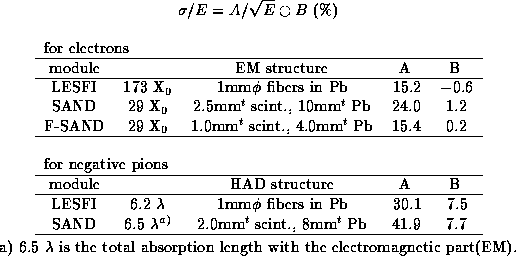The JLC group has made two kinds of test modules corresponding to one unit of the hadronic
part of the calorimeter(Fig.13), as reported at LCWS93. [4]
The standard calorimeter is a sandwich-type lead and plastic scintillator(SAND);
the second option is a lead/scintillating fiber calorimeter(LESFI). Both are so
called compensating calorimeters providing the same energy deposit for electrons and
pions(hadrons).
At this workshop, K.Ishii presented the results of beam tests using
1![]() 4GeV electron and negative-pion beams at KEK. [26]
The results are summarized in Tab.2.
4GeV electron and negative-pion beams at KEK. [26]
The results are summarized in Tab.2.

Table 2: Beam-test results of the test calorimeter modules by 1![]() 4GeV
4GeV ![]() ,
,![]() beams at KEK. All the test modules have the same cross section (20
beams at KEK. All the test modules have the same cross section (20![]() 20 cm
20 cm![]() ).
).
For electrons, the LESFI and the fine sampling (F-)SAND fulfill the required energy
resolutions, including the constant term.
For pions, the large constant terms(B![]() 8%) were observed in both modules. The
cause was speculated to be a lateral shower leakage, which will be checked by
a beam test.
8%) were observed in both modules. The
cause was speculated to be a lateral shower leakage, which will be checked by
a beam test.
In order to readout the signals in a 2-Tesla solenoid field, three kinds of devices
(fine mesh photomultiplier(FMPMT), hybrid photo-diode(HPD) and vacuum avalanche
photo-diode(VAPD)) were also tested in a magnetic field of up to 2.5Tesla.
While FMPMT and HPD were operational even in 2.5Tesla, HPD seems to be better
because of the stable gains in B=0![]() 2.5Tesla and the uniform response for any
direction of the magnetic field. Although the present readout uses wavelength shifters,
a CDF-type tile/fiber readout [27] will be considered in the future for no gap
between the modules.
2.5Tesla and the uniform response for any
direction of the magnetic field. Although the present readout uses wavelength shifters,
a CDF-type tile/fiber readout [27] will be considered in the future for no gap
between the modules.